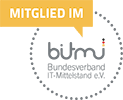After the importance for the economic and innovative added value of Software-as-a-Service solutions for SMEs became clear in the last article, the question of how to proceed when developing a SaaS product should now be answered. It is particularly important to harmonise the desired ideas with the best possible feasibility already at the conception stage. We will now go through the first three basic steps.
Step 1: Analysing the market
For the long-term success of a Saas solution or product, the first step is to analyse the market. Market research has the advantage of providing a good overview of how competitors are doing and how potential customers would react to the solution. Classic questions can be helpful, such as: Who is my target group and what are their main concerns and needs? Who are my competitors and what business models are they pursuing? On the one hand, research prevents mistakes that have already been made and, on the other hand, validates whether a market or needs exist for the target customer for which he would be willing to pay a corresponding price. The business model can then be aligned with a recurring and sustainable benefit and, in the best case, remains attractive to a large audience.
The question is, of course, how to get insights into the (secret) desires of potential customers? Experience shows that regular user research measures such as qualitative interviews and testing such as litmus testing best reveal what current needs or problems exist. With this method, the customer takes centre stage and has his say. This work is very valuable because on the one hand ideas can be tried and tested and at the same time there is an intensive exchange with the customers. In the long run, this leads to a better understanding of the problems they face in everyday life – a living research laboratory, so to speak.
Step 2: Conceptualizing a stable business plan
Taking into account the market research, the operational planning for the development of a SaaS product or solution can now begin. This involves clearly defining the most important points, which can be divided into the following headings:
First, it should be defined in a catchy sentence how the SaaS product differs from others. It should be clear what the added value for the customer is and how the product is reflected in the identity of the entire company. This is because the product should feed into the overall business goals. It is essential to formulate the vision and the desired goals. Subsequently, the acute problem that the SaaS product solves should be defined in a problem definition and the customer’s “pain point” should be crystallised. This then goes hand in hand with the question of which means will be used to address and reach the desired target audience. Within the marketing strategy, it can then become clear which partnerships, channels and measures should be taken.
An important part of the business plan, in addition to the goals and operational steps, is the calculation of a monetisation strategy. Here, everything revolves around the question of how money is to be earned with the SaaS product: which different subscription plans are available, what kind of extended support or different upgrades are possible (see step 3). This calculation is crucial in order to be able to offer the customer the best offer and at the same time estimate one’s own primary expenses and necessary income. Based on this, the necessary sources of funding can then be considered – from VC capital or crowdfunding, there are no limits there.
Even though it is clear that such a business plan represents a snapshot and will always change in the process.
Step 3: Determining a suitable pricing model
It is not so easy to determine the right pricing model or strategy for the SaaS solution, because a balance should be found between the value for the customer and one’s own profit margin. If too little is charged, it will take longer to recoup the initial investment and there is a risk of having to make further investments. If the customer is charged too much, the acceptance of the SaaS product can stagnate and potential new customers are deterred. Therefore, the pricing model should definitely be adapted to the needs of the target users and there are various options, such as
- Consumption-based pricing, which means that the customer pays depending on the amount of use or consumption.
- freemium, i.e. the free version that offers a limited range of functions, which then creates the possibility of a paid upgrade
- flat rate, which offers an entire product or a bundle of functions for a monthly or annual price
- pricing per active user, i.e. when the entire product is paid for per user
- pricing per feature, i.e. a tiered pricing model where different features are offered piece by piece.
All price models have advantages and disadvantages – for example, if you choose the flat rate model to offer all customers access to all features for a fixed fee, it is easy to sell them. This makes sales and marketing easy, as only one offer needs to be explained. However, one disadvantage is that it becomes difficult to generate upsells to existing customers as a fixed price is established and fixed. To get around this, one could approach the tiered pricing model. However, the disadvantage here could be that it can be difficult to determine which features users want. The best indication of this is the market analysis at the beginning, which already shows tendencies on the part of potential customers.
Once a model has been decided, all energy and resources can be put into the necessary requirements of the SaaS solution and the operational and technical part of the development can begin.
Summary:
It is worthwhile to put time into a structured analysis and planning for the potential SaaS product. This is because the business plan and the pricing model can be solidly built on the basis of the market and customer analysis and the long-term strategy for the product, the business model and also the entire company can be set. This effort should not be spared.




